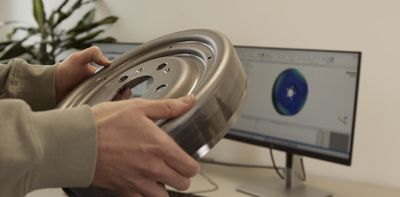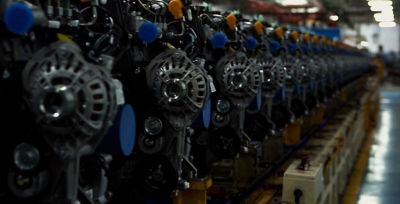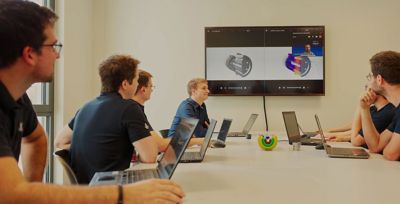-
United States -
United Kingdom -
India -
France -
Deutschland -
Italia -
日本 -
대한민국 -
中国 -
台灣
-
Ansysは、シミュレーションエンジニアリングソフトウェアを学生に無償で提供することで、未来を拓く学生たちの助けとなることを目指しています。
-
Ansysは、シミュレーションエンジニアリングソフトウェアを学生に無償で提供することで、未来を拓く学生たちの助けとなることを目指しています。
-
Ansysは、シミュレーションエンジニアリングソフトウェアを学生に無償で提供することで、未来を拓く学生たちの助けとなることを目指しています。
ANSYS BLOG
December 7, 2023
Reimagine Mobility in a Snap with Simulation
Tune in to Episode 4 of “Driven by Simulation” to see how simulation helps electric vehicle designs go further.
Though many of us are still contemplating what’s ahead, Wired magazine sees a future of EV design defined by skateboards (vehicle platforms) and top hats (the body and interior of a vehicle). Modularity isn’t new, but the universality of a modular EV chassis design would lend itself to endless configurations in the swapping of components. And with 60% fewer powertrain components alone, EV platforms offer greater design flexibility than traditional builds.
In a fast-paced, demand-driven, ever-evolving electrified market, modularity may help original equipment manufacturers (OEMs) reach more customers in the future by satisfying their demands for reasonably priced vehicles that can go further on a single charge.
Episode 4 of the Ansys online docuseries “Driven by Simulation” shows how automotive innovators DeepDrive, Ashok Leyland, and ZF are achieving more sustainable outcomes by design.
DeepDrive Reinvents the Wheel with a Motor Inside
Efficiency, next to price, is top of mind for consumers in the current EV market. Range anxiety — the fear of not being able to reach your destination without access to a charging point — is real. In response to this collective angst, a lot of emphasis has been given to the battery, and its ability to maintain a state of charge over long distances.
DeepDrive is proving through innovation that there’s more than one way to efficient power delivery. In most EVs, the motor is positioned under the hood or close to the wheels, powered by rechargeable Li-ion batteries. During acceleration, the motor uses energy from the battery to turn the wheels. During this transaction, 25% of the electricity generated is lost somewhere along the power chain.
Using simulation, DeepDrive was able to integrate electric hub motors into the four corners of an EV as part of the wheel assembly, shortening the path from the motor to the wheel. As a result of this new configuration, more power is delivered where it’s needed most, reducing energy loss to deliver a range advantage of 20%.
“When talking about change in mobility, it's really important to be more sustainable, to be more efficient, to reduce energy consumption of vehicles,” says Alexander Rosen, co-founder and system design engineer at DeepDrive. “All of those concepts are enabled by all-in-wheel motor technology. And the DeepDrive motor technology … makes a significant contribution to that.”
This in-wheel electric motor configuration also eliminates the need for a transmission system — which, with the help of Ansys simulation software, makes electric vehicles lighter, and frees up more space for new design possibilities.

Ashok Leyland Unlocks Millions of Sustainable Builds
Moving the motor to the wheels is certainly one way to optimize an EV’s efficiency. Ashok Leland, however, claims to have unlocked 6 million. By splitting a vehicle design into simple building blocks, the commercial vehicle manufacturer can pull multiple combinations together to do more for their customers. Simulation is the tool that helps it all come together.
Dr. N. Saravanan, chief technical officer at Ashok Leyland, sees a direct parallel between his modular vehicle designs and LEGO sets in the easy, intuitive way all of the bricks come together to create something new. "You can take simple building blocks, LEGO blocks, and build complex structures … But the basic fundamentals, it's a bunch of pieces of a plan with a common interface."
The interchangeable nature of the building blocks themselves is key to modularity. In automotive, it’s based on the idea that when working from a universal platform (or skateboard), components that share a common interface can be assembled in various combinations. Those combinations can then be validated in a virtual environment to satisfy requirements for weight, performance, and design.
By simply moving things around, manufacturers have the freedom to configure EVs that are lighter, more efficient, and less costly to assemble. More free space enables more aerodynamic vehicle designs requiring less power — all of which can result in smaller batteries and even lighter vehicles.
It’s all part of Ashok Leyland’s commitment to building robust, sustainable, modular commercial vehicle solutions quickly that are tailored to customers’ unique expectations for efficiency, performance, and cost — using simulation as their guide.

ZF Delivers the Total eDrive Package
When it comes to eDrive systems, ZF has the experience and expertise to bring it all together. A global technology leader at the forefront of electrification, the automotive solutions manufacturer relies on simulation to design systems that can be easily integrated into the skateboard of a vehicle.
“We're using simulation from the beginning on, starting with the component level, subsystem level to prove whether systems fulfill requirements in terms of durability and everything, (and) going to the next level to see what is happening if software’s integrated,” says Joachim Noak, global chief engineer, simulation and NVH at ZF. “Is the product still doing what it is supposed to do, and that is mainly based on the simulation level.”
The result is a single-source eDrive system defined by:
- An electric motor (EM) with a common electromagnetic design.
- A highly standardized, fully scalable inverter that converts and delivers power to the drivetrain.
- A reduction gear unit to reduce EM output speed or increase torque as needed.
- Modularly designed, scalable electric driveline software.
Examining all these elements in a simulation environment helps ZF engineers build ultra-efficient, modular systems that can be fully optimized for the cost-conscious, range-optimized, or performance-oriented applications representing more than 80% of ZF’s customer requests.
If you haven’t already, tune into Episode 4 of “Driven by Simulation” to see how Ansys simulation is driving the future of electric vehicle design at DeepDrive, Ashok Leyland, and ZF.












